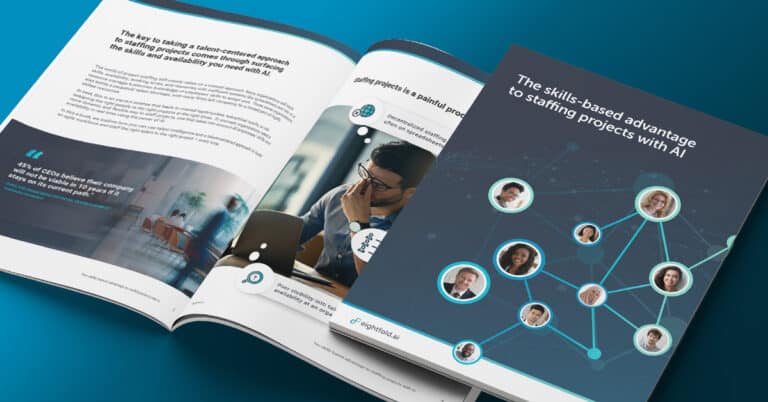
The skills-based advantage to staffing projects with AI
The skills-based advantage to staffing projects with AI
The world of project staffing still mostly relies on manual approaches. Many organizations track skills, availability, booking times, and resources with inefficient systems like spreadsheets and rely on a resource manager’s previous knowledge of employees’ skills to assign work. Those same organizations also battle a perpetual talent shortage, with many firms left competing for a limited pool of highly skilled resources.
To succeed, organizations need a more dynamic, flexible way to staff projects — one that takes into account all employees’ skills and availability in real time using the power of AI. In this guide, we explore how you can use AI and a talent-centered approach to build an agile workforce and staff the right talent to the right project — every time.
With Resource Management, you can:
- Move away from a jobs-centered approach to transform into a talent-centered organization.
- Match the right work to the right skills at the right time — all in one system.
- Deliver better results for clients, improve margins, and keep talent off the bench and engaged with projects that add skills to your firm’s portfolio.
The key to taking a talent-centered approach to staffing projects comes through surfacing the skills and availability you need with AI.
The world of project staffing still mostly relies on a manual approach. Many organizations still track skills, availability, booking times, and resources with inefficient systems like spreadsheets and rely on a resource manager’s previous knowledge of employees’ skills to assign work. Those same organizations also battle a perpetual talent shortage, with many firms left competing for a limited pool of highly skilled resources.
At best, this is an inexact science that leads to missed opportunities, suboptimal results, or not assigning the right people to the right projects at the right times. To succeed, organizations need a more dynamic and flexible way to staff projects, one that takes into account all employees’ skills and availability in real time using the power of AI.
In this e-book, we explore how you can use talent intelligence and a talent-centered approach to build an agile workforce and staff the right talent to the right project — every time.
The talent-centered organization
Historically, organizations have hyper-focused on the role, whether that’s for hiring practices, succession planning, or internal mobility. The typical recruitment process starts with defining a job and hammering out a job description, requirements, region, compensation, and so on. With everything in place, recruiters advertise one job to as many people as possible.
Talent-centered organizations flip this framework on its head. Instead of starting with jobs, this model starts with people. It uses AI and real-time insights to understand a person in the context of their work, skills, and capabilities.
Rather than exposing one job to as many people as possible, this model applies a person’s skills and interests to as many opportunities as possible — projects, gigs, roles, events, mentorship programs, and more. Some organizations, like those in the professional services industry, are doing this to some extent as they already live in a project-based world. This more flexible approach to staffing allows for speed and agility rather than inefficiency and rigidity, as it uses real-time data to reveal what someone can do and where to deploy them best to capitalize on their strengths.
Project staffing needs talent intelligence
Through the power of deep-learning AI, talent intelligence platforms examine the entire life cycle of billions of data points about careers to provide real-time data on what skills someone has, which skills your organization needs, and how to best acquire and develop those skills. Until recently, talent intelligence has primarily been used by HR and talent leaders looking to acquire or manage skills within their organizations.
Now, organizational leaders can also use the power of talent intelligence to inform their plans to build, buy, or borrow talent when it comes to project staffing. Even better, these talent insights are continuously updated and dynamic. Adjacent skills, learnability, and capabilities are easily found in one place to help you widen the talent pool and find the best candidates possible.
All this skills data resides in the same place where you’re building your talent strategies. As a result, your talent strategy shifts from building a 2D and rigid talent pipeline to a diverse 3D talent portfolio, where employees can branch out in their careers in a way that suits their aspirations and your organization’s goals and give you a more universal view of your resources.
Benefits of a talent-centered approach
With a universal view of the skills within your organization, you can staff projects using a talent-centered approach. Let’s further explore the top benefits for professional services organizations.
Eightfold Resource Management
Eightfold Resource Management integrates with your staff’s availability and booking systems so you can surface the best possible fit for a project based on skill sets, availability, and other signals, including career aspirations and goals — all in a single, centralized system.
Additionally, as employees complete various projects, their skills and experiences are captured in your talent intelligence system, updating in near real-time, giving you dynamic information about skills, compatibility, and availability.
With AI-powered talent intelligence and Eightfold Resource Management, you get a full view of the entire talent bench and the power to deploy people to the most beneficial and profitable places possible.
You might also like...
Get the latest talent news in your inbox every month
By submitting this form, I consent to Eightfold processing my personal data in accordance with its Privacy Notice and agree to receive marketing emails from Eightfold about its products and events. I acknowledge that I can unsubscribe or update my preferences at any time.
